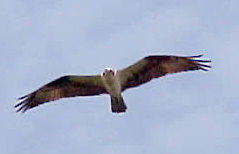ARLINGTON, Va. A regional fisheries commission has agreed to cap the commercial catch of menhaden in the Chesapeake Bay.That cap is intended to give scientists time to assess the health of the tiny but important bait fish.
Meeting in Arlington, the Atlantic States Marine Fisheries Commission voted today to set the cap through 2010....
The annual catch will be limited to 109-thousand-20 metric tons, with flexibility for years when the catch is up or down.
Showing posts with label Osprey. Show all posts
Showing posts with label Osprey. Show all posts
Sunday, August 20, 2006
Limits on Menhaden Catch
Last week we reported that Osprey in the Chesapeake Bay area may be suffering due to the decline in Atlantic Menhaden. The fish, which are crucial to the diets of Osprey and other birds, have been in decline for the past two decades. At the end of the week, the Atlantic States Marine Fisheries Commission acted on the problem:
Tuesday, August 15, 2006
Declining Menhaden May Threaten Osprey Reproduction
 The Osprey population of the Chesapeake Bay region has been adversely affected by the decline of Menhaden, a small fish, along the Atlantic coast. The Chesapeake has one of the largest breeding populations of Osprey anywhere, with close to 4,000 pairs. Within the last decade, researchers have found increasing numbers of malnourished and dying chicks. They argue that this is because the Ospreys' preferred food, Menhaden, has declined sharply over the past two decades.
The Osprey population of the Chesapeake Bay region has been adversely affected by the decline of Menhaden, a small fish, along the Atlantic coast. The Chesapeake has one of the largest breeding populations of Osprey anywhere, with close to 4,000 pairs. Within the last decade, researchers have found increasing numbers of malnourished and dying chicks. They argue that this is because the Ospreys' preferred food, Menhaden, has declined sharply over the past two decades.Menhaden filter the bay's waters by eating the microscopic plants and animals that consume dissolved oxygen needed by other aquatic life. In turn, they're a primary food source for sport fish, such as striped bass, bluefish and weakfish, and seabirds, including loons, gulls and gannets.
Ongoing scientific research focuses mostly on the ecological role that menhaden fill underwater. Broader public awareness has centered on the fish's importance to recreational anglers. But, like striped bass, ospreys favor meals of menhaden over other fish.
"Of everything we know about the bay, this is one of the fundamental food chains: Ospreys eat menhaden," said Paul Spitzer, a Maryland ecologist who specializes in birds.
One study found that menhaden made up 70 percent of the diet of ospreys nesting on Mobjack Bay off the coasts of Gloucester and Mathews counties.
Other studies done along the Atlantic coast have turned up similar results.
Menhaden swim in large schools that skim the water's surface, and they move straight ahead rather than dart around like other fish.
That makes them a perfect prey for circling ospreys, as well as Omega Protein's spotter planes, which radio a school's coordinates to waiting boats.
A fishery commission is considering imposing limits on harvesting of Menhaden while more research is done to determine the causes of the fish's decline.
Monday, April 25, 2005
Osprey Live From The Anacosta

Earth Conservation Corps
Earth Conservation Corps and EarthCam bring you a real-time view of an osprey nest located on the Anacostia River in Washington, D.C. The nest, which looks like a huge pile of sticks, is on a pier under the Frederick Douglass Bridge and is occupied by two chicks and their parents.
The Earth Conservation Corps' Osprey Nest webcam is part of an educational, youth media project funded by the National Geographic Education Foundation. Fifth-grade students from Neval Thomas Elementary in Northeast Washington are following Earth Conservation Corps members on their field studies of raptors on the Anacostia River, and plan to use the webcam as part of an on-going, five-year study of birds of prey on the river.
Subscribe to:
Posts (Atom)
